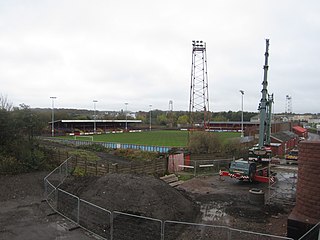
Doncaster Rovers Football Club is a professional association football club based in Doncaster, South Yorkshire, England. The team compete in League Two, the fourth tier of the English football league system. The club play their home games at The Eco-Power Stadium, having moved from Belle Vue in 2007. Their home strip consists of red and white hoops, which has been the main design of the club's home shirt since 2001 through different variations. Rovers often sport a third kit each season promoting mental health charity Campaign Against Living Miserably (CALM), with proceeds of the particular home games being donated to said charity.

The Northolme is a football ground in Gainsborough, Lincolnshire, England. It is the home ground of Gainsborough Trinity, it has a capacity of 4,304, of which 504 is seated.
Leamington Road was a football ground in Blackburn in England. It was the home ground of Blackburn Rovers between 1881 and 1890.
Linthorpe Road was a cricket and football ground in Middlesbrough in England. It was the home ground of Middlesbrough Cricket Club and Middlesbrough F.C.

Borough Park is a football stadium in Workington, Cumbria, England. The home ground of Workington A.F.C., it has a capacity of 3,101, of which 500 is seated.
Horsley Hill was a football and rugby league ground and greyhound racing track in South Shields.
Abbey Park was a football stadium in Grimsby, Lincolnshire, England. It was the home ground of Grimsby Town between 1889 and 1899.
The Athletic Ground was a football ground in Loughborough in England. It was the home ground of Loughborough F.C. between 1886 and 1900.
Barley Bank was a cricket and football ground in Darwen in England. It was the home ground of Darwen F.C. during their time in the Football League.
Raikes Hall was a football ground in Blackpool, Lancashire, England. It was the home ground of Blackpool F.C. between 1888 and 1899.
The Town Ground was a football ground in Nottingham in England. It was the home ground of Nottingham Forest, and the first ground to host a football match using crossbars and goal nets.
Clifton Grove was a football ground in Rotherham, England. It was the home ground of the original Rotherham Town club.
Green Lane was a football ground in Stockport in England. It was the home ground of Stockport County between 1889 and 1902, and was used during the club's first two seasons in the Football League.

Pike's Lane was a football ground in Bolton, England. It was the home ground of Bolton Wanderers between 1880 and 1895, and the venue of the first goal scored in league football anywhere in the world.
Portland Park was a football ground in Ashington, England. It was the home ground of Ashington A.F.C. between 1909 and 2008. It also hosted greyhound racing from 1936 until 1993.
St John's Lane was a football ground in Bristol, England. It was the home ground of Bristol City between 1894 and 1904.
Sandheys Park was a football ground in New Brighton, England. It was the home ground of New Brighton A.F.C. from 1921 until World War II.
The Tower Athletic Ground was a sports ground in New Brighton, Merseyside, England. It was the home ground of both New Brighton Tower and New Brighton A.F.C.

Thorneyholme Road is a cricket and former football ground in Accrington, England. It is the home ground of Accrington Cricket Club, and was the home ground of Accrington F.C. from 1878 until 1896 when they dissolved.
Cathkin Park was a football ground in the Crosshill area of Glasgow, Scotland. It was the home ground of Third Lanark from their foundation in 1872 until they moved to New Cathkin Park in 1903. It also hosted Scottish Cup final matches and the Scotland national team.





